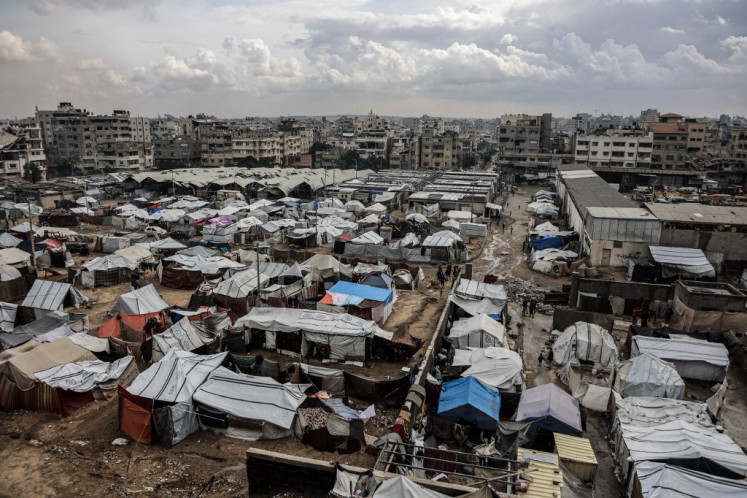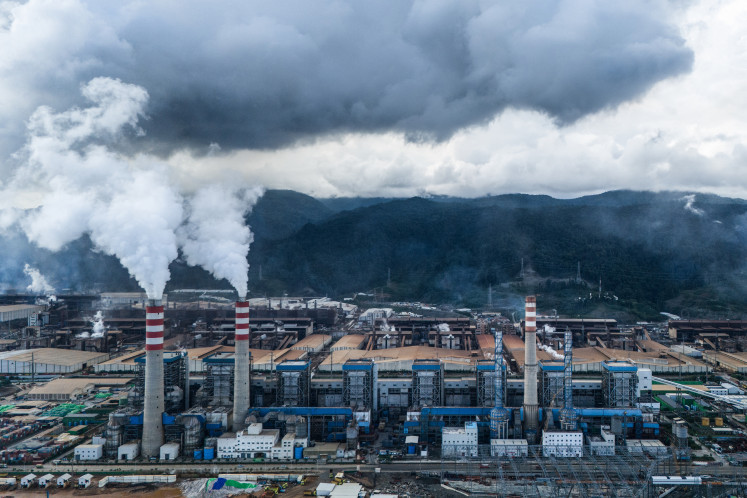Popular Reads
Top Results
Can't find what you're looking for?
View all search resultsPopular Reads
Top Results
Can't find what you're looking for?
View all search resultsConnecting ARTJOG 2019 and the Anthropocene
This year’s ARTJOG in Yogyakarta is using the theme: “Common | Space”
Change text size
Gift Premium Articles
to Anyone
T
his year’s ARTJOG in Yogyakarta is using the theme: “Common | Space”. Given the current situation in which we are confronted with a myriad of spaces where we intermingle or overlap one another, I find common space useful as it presents the notions of heterogeneity and connections.
How ARTJOG 2019 is using art as a platform for discussing the environment and the Anthropocene epoch and for raising awareness of the current ecological crises is interesting. Coined by Eugene Stoermer and Paul Crutzen in the early 2000s, the Anthropocene references a geological epoch that started when humans became the main agents of geologic change.
Although etymologically the term Anthropocene has had a conflicted history and the notion of the Anthropocene has been disputed, it has been widely used in various fields by scientists, politicians, anthropologists, humanists, artists, curators and others as a platform to promote an awareness that we are making indisputable impacts on the environment on a global scale.
In the month-long ARTJOG 2019, we can see how artists and curators develop narratives about the environment and the Anthropocene. Some artists present artworks that reconfigure the relationship between humans and the environment. Some have engaged with environmental degradation, climate change, deforestation, plastic problems and exploitation of the Earth in their works.
In relation to the climate in particular, Bruno Latour, a French philosopher and one of the advocates of the Actor-Network Theory (ANT) in science and technology studies, proposes a term, “common cosmopolitical concern”, to highlight the fact that the climate has always been important to people, that it is a shared milieu we occupy and that it deserves our deep attention.
Apart from the exhibition, ARTJOG, held from July 25 to Aug. 25, has clearly helped boost the local economy of its host city Yogyakarta. It creates more business opportunities, including for hotels, transportation services and food production. Many local art galleries have also benefited from the event by exhibiting their own works.
Ironically, ARTJOG seems to have left behind a large carbon footprint, like for travel and electricity. People traveling to and from ARTJOG by flying, driving, or using other means of transportation may account for most of the carbon emissions of this event. It is likely that ARTJOG has consumed a huge amount of electricity for lighting, operating appliances, electronics, computers, cooling indoor spaces and other things.
As pressure to act on global warming is mounting, some may question whether the trend to air-condition indoor spaces and the excessive use of electricity is viable. Moreover, Indonesia primarily relies on fossil fuels to generate electricity.
I’m not saying that by addressing the Anthropocene the artworks and the exhibition would solve the problems and probably the ecological problems we are facing are not going to be solved solely by the artworks or by the exhibition. The Anthropocene narrative is undeniably complex and has a rhizomatic network of colonialism, capitalism, politics, science and technology — to name a few.
However, I believe that major events like ARTJOG, one of the must-watch art exhibitions in Southeast Asia, could have made more interventions on these environmental issues by framing the exhibition closer to the everyday so that audience at least can know what it means to feel and to live in the Anthropocene.
In fact, what I found disturbing was not exactly inside the air-conditioned exhibition building, but outside, where the heat of the sun was intense, where people carelessly tossed cigarette butts on the ground, where customers didn’t clean up their messes after eating at the food stalls in ARTJOG, where traffic congestion was maddening and where garbage piled up not far from the exit door despite Yogyakarta having declared a darurat sampah (waste emergency) after being flooded by garbage from its inhabitants and the tourism industry.
Although it is not easy to see the shift of terminology from “art fair” to “art festival” as a neutral change of labels as ARTJOG and commercialization of artwork have become inseparable, ARTJOG’s intention to change this stereotype and to use “festival” instead should be greatly appreciated.
Indeed art should be celebrated by everyone. If ARTJOG has made a commitment to the environment, it should extend to the exhibition and other events in ARTJOG. Addressing sustainability and understanding the environmental impact of ARTJOG could be on ARTJOG’s agenda. That is to say, ARTJOG could promote art as a mode of both thought and praxis.
In navigating the Anthropocene, I find it necessary to refer to Donna Haraway’s “response-ability”, which means the cultivation of the capacity to respond in the context of anthropogenic destruction and in the context of living and dying well with others. Haraway, one of the leading practitioners of the politics of nature and culture, says that “response-ability” is not something we are bound to do that arises out of a demand or a sense of duty. Rather, it is a kind of desiring. For her, instead of reacting to a crisis, cultivating “response-ability” is more productive and energizing.
Today creativity has been accepted as a new currency and has been linked to technology, industry and the economy. The uptake of the creative economy in the country first emerged during Susilo Bambang Yudhoyono’s administration. Despite some criticisms, especially on how it has been adopted in developing countries like Indonesia, it is obvious that the creative economy has become a transformative force.
The Creative Economy Agency (Bekraf) has put Indonesian visual arts on one of its main agendas and this is where ARTJOG plays a role in contributing to Indonesia’s economy and in promoting Indonesian visual art nationally and internationally. With Finance Minister Sri Mulyani Indrawati opening ARTJOG 2019, it is clear that the event has been gaining momentum and is greatly supported by the state.
There is no time like the present for ARTJOG to make a real change and to “mark a space”. Henri Lefebvre, a prominent figure in spatial practices, put it this way in his book, The Production of Space: “Ideas, representations or values which do not succeed in making their mark on space […] will lose all pith and become mere signs, resolve themselves into abstract descriptions, or mutate into fantasies. […] Space’s investment — the production of space — has nothing incidental about it: It is a matter of life and death.”
_________________________
The writer graduated from the School of Philosophical and Historical Inquiry (SOPHI) at the University of Sydney, Australia.










